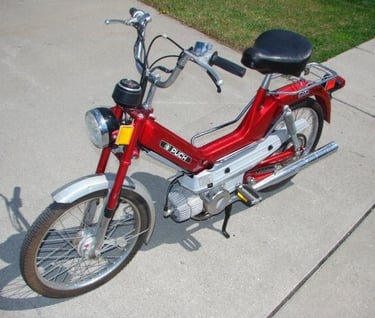The History of Mopeds: From Post-War Necessity to Modern-Day Trend
This article provides a comprehensive overview of the history of mopeds, from their invention in the early 1900s to their recent resurgence in popularity due to environmental concerns. It discusses how mopeds became popular in post-war Europe and the United States in the 1970s, and how they are now viewed as a sustainable alternative in urban transportation.
MOPEDSMOPED CULTURE
Iain Mackay
7/27/20232 min read


The History of Mopeds: From Post-War Necessity to Modern-Day Trend
Introduction
Mopeds, a unique fusion of bicycles' simplicity and motorcycles' power, have had a fascinating journey through history. From being an invention trodden by design challenges, through their rise in popularity due to post-war transportation necessities, to their recent resurgence with environmental concerns, the tale of mopeds is a captivating one. This article navigates through the twists and turns of the moped's history, providing a comprehensive overview of its past, present, and potential future.
The Birth of Mopeds
The motorized scooter can trace its roots back to the early 1900s, with Arthur Hugo Cecil Gibson at the centre of its creation. Gibson patented the concept for a self-propelled vehicle, a design that would transform the personal transport scene. He manufactured this concept into reality in New York in 1916, producing the first commercially recognised motorized scooter, also known as 'The Autoped.' Being the first of its kind, The Autoped carried its engine above the front wheel and was controlled via the steering column which managed both clutch and brakes. Speeding at a safe 20 mph, albeit unstable beyond this, it instantly became a sensation among masses due to its novelty, marketing itself as a reliable commuting alternative.
Popularity Surge in Post-War Era
With the conclusion of World War II, the world saw a growing demand for economical and efficient modes of transportation. Recognizing this gap, mopeds quickly emerged as a popular choice. The war-ravaged countries saw mopeds, especially brands like Vespa, as affordable, accessible, and easy-to-use vehicles that could perfectly fit their limited resources and extensive transport necessities. These two-wheelers became common sights on roads across Europe, transforming the transportation landscape with their practicality.
The American Moped Craze of the 70s
Mopeds entered the United States in the 1970s, ushering in an era of moped frenzy. Unlike Europe, mopeds were a novelty in the U.S., and they were initially met with legal confusions as they didn't fit the existing vehicle classifications. The rise in fuel prices during this period made mopeds a standout choice with their attractive fuel efficiency. The National Highway Traffic Safety Administration recognized mopeds as 'motorized bicycles' in 1974, paving the way for their popularity. The Motorized Bicycle Association was formed later the same year to regulate the use and safety of mopeds. Thanks to efforts by enthusiasts like Serge Seguin, who campaigned across the country promoting the use of mopeds, they managed to find their niche in different U.S. states.
Mopeds: The Modern-Day Trend
Mopeds have evolved from being a necessity to a lifestyle statement in today's world. These two-wheelers have made a comeback, primarily due to environmental concerns and urbanization. With major cities becoming increasingly congested, mopeds offer a solution as they are easy to manoeuvre, require less parking space, and produce fewer emissions compared to cars. Modern mopeds, particularly e-mopeds, are viewed as part of a broader movement towards sustainable and efficient transportation alternatives. E-mopeds, with their eco-friendliness and affordability, have embraced the needs of the 21st century, contributing to their current popularity as modern-day trends.
Conclusion
Mopeds, through their historical and cultural journey, have proven their worth time and again. From their advent, their rise during the post-war era, their foothold in the American market during the 70s, and their current status as a sustainable alternative in the urban transportation scene, mopeds demonstrate adaptability and resilience. Their history reflects the ever-evolving transportation needs, and their modern popularity suggests their crucial role in future urban mobility. Environment-friendly, economical, and practical - mopeds are more than just two-wheelers; they are a testament to human ingenuity and adaptability.
